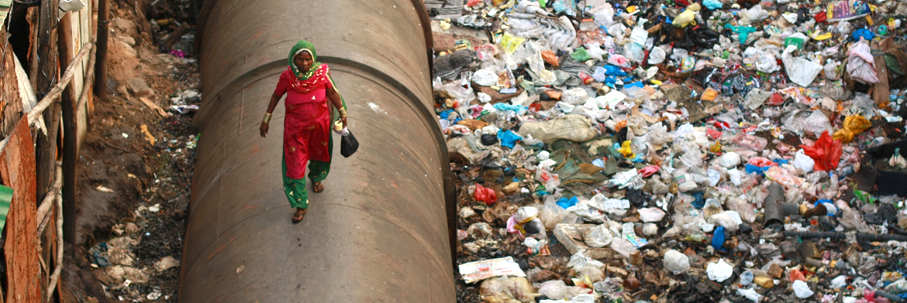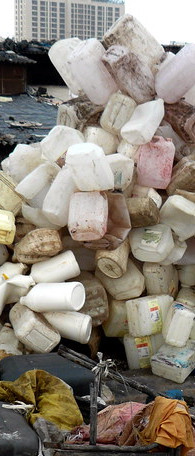
In its rush to introduce a single-use plastic ban India risks creating legislation that covers only a tiny proportion of polluting products and penalises small enterprises whilst leaving big business unscathed. Governing Plastics Network researcher Shashi Kant Yadav argues that to make a difference legislation in developing countries must address plastic not as a product but as a process.
Last month, India implemented a nationwide ban on certain single-use plastic products. The ban covers “manufacturing, importing, distributing and selling” any of the listed products. The listed products include earbuds with plastic sticks, plastic sticks for balloons, plastic flags, candy sticks, ice-cream sticks, polystyrene decoration, plastic plates, cups, glasses, cutlery such as forks, spoons, knives, straws, et cetera. The ban does not include many of the products used in the widely consumed mass goods such as plastic packaging of products like chips, biscuits, and soap and tobacco, and early estimates suggest that the ban will only impact two to three per cent of India’s total plastic production.
This two to three per cent is mainly made up of small and medium-sized businesses that provide daily earnings for poor sections of Indian society who are struggling to meet their basic livelihood demands following the COVID-19-related economic setback in India. Many of these tiny firms have characterised the prohibition as ‘hurried,’ because raw materials for making replacements for the prohibited commodities are either unavailable or too costly in India. To manufacture biodegradable products, for example, many of these firms must move their raw material from polymers to paper (typically imported from Finland and Sweden), which raises production costs by 75%. Moreover, even if India’s plastics ban is fully enforced, it will have no effect on large plastics producers since they are in special economic zones in India, which are mostly exempt (depending on the regional level regulations) from the restriction on producing the specified commodities.

The All-India Plastics Manufacturing Association (AIPMA), a non-profit body representing plastics manufacturers in India, expressed alarm over the prohibition, claiming that 88,000 single-use plastic manufacturing units might go bankrupt as a result of it. It also predicted that millions of daily wage labourers will be forced into abject poverty, urging a balanced approach to the prohibition by offering alternatives that do not cost exponentially more than the feedstock used to create plastics. The AIPM also proposes lowering customs duties on paper imported from European nations so that small and medium-sized businesses may successfully migrate from plastics to paper-based alternatives.
Plastics manufacturing on the rise in India
Plastics are the oil and gas industry’s ‘Plan B’ for survival. Plan A, the energy sector, has come under scrutiny due to international climate change discussions. The march toward Plan B is now in full swing. Ethane, a by-product of natural gas and oil extraction, is gradually replacing naphtha as a feedstock for the manufacturing of plastics across the world. Ethane is mostly imported from the United States (US) to the European Union and India. Following that, India refines feedstocks such as ethane and manufactures plastics products, which are subsequently exported as houseware goods for rich countries like Canada, the US, and the UK. Increase in plastics manufacturing and refining activities in India can significantly increase toxicity levels in air.

The plastics industry in India is expanding at a rapid pace. The Ministry of Commerce and Industry of India aims to grow the country’s plastic exports from US$ 13.34 billion in 2022 to US$ 25 billion by 2025. In pursuit of achieving this aim and increasing waste recycling capacity, the Indian government has developed a ‘plastics park‘ plan that would provide money up to 50% of project expenditures, with a maximum cost of US$ 5 million per project. The ‘plastic parks’ are primarily industrial zones exclusively for plastic enterprises and allied industries, including a whole range of companies required by the plastics processing community from material and machinery suppliers, plastics processing companies, plastic recycling companies including waste management systems.
Unlike in Western countries, ‘plastics’ as a process is a more significant concern in India rather than plastics as an end-user ‘product.’ As a process, ‘plastics’ pose great concern as their manufacturing emits greenhouse gases and further aggravates air pollution issues in India. Since developed countries import plastics from developing ones, such as India, the pollution emitted by the ‘process’ is bound to increase in the developing countries. This will overall increase the vulnerability of the most economically deprived population of the world toward air pollution and climate change. It is important to note here that India has 63 of the world’s 100 most polluted cities. 2.3 million people died prematurely because of pollution in India, in 2019; 1.6 million fatalities were caused by air pollution, and 500,000 by water contamination.
Therefore, it is important to contextualise how single-use plastic bans impact different stakeholders in a developing economy like India to ensure that such a ban does not disproportionately impact poorer sections of society.


Interesting to read how an attempt to control one problem may itself have dire consequences. There is a danger in jumping to apparent solutions in haste.